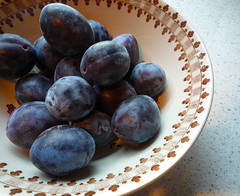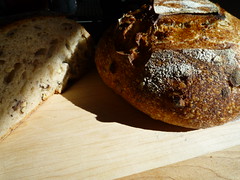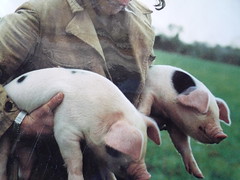Plum Dandy
 fig. a: Italian prune plums
fig. a: Italian prune plums
Let's just say that you happen to be living in a place where you can still get some of those beautiful Italian prune plums grown locally. Nice ones. Juicy ones. In October. Yeah, I know--it seems hard to believe, but there are such places.
 fig. b: hazelnut sourdough
fig. b: hazelnut sourdough
Let's also say you have a half a loaf of day-old bread kicking around. And let's just say it's half a loaf of a day-old sourdough. Who knows? It might even be half a loaf of a sourdough you baked yourself. It might even be half a loaf of a hazelnut sourdough you baked yourself. It's certainly possible.*
And, finally, let's say that the temperatures at night have been getting a little nippy (as they're supposed to at this time of year, in this part of the hemisphere). And you're in the mood for a lovely fall dessert--a simple one, a heart-warming one.
Well, you've come to the right place.
 fig. c: Hugh F-W**
fig. c: Hugh F-W**
Michelle got me a copy Hugh Fearnley-Whittingstall's The River Cottage Cookbook late this summer (better late than never, right?). And although I've found the book full of inspiration, and I've since made good use of it, for some reason, it was one of the book's simplest, homeliest recipes that caught my attention the first time I leafed through it: Fearnley-Whittingstall's bread pudding with plums.
 fig. d: bread pudding recipe
fig. d: bread pudding recipe
From the moment I laid eyes on it, I just knew I was going to love it. And I couldn't wait for the Italian prune plums to arrive on the scene. Fearnley-Whittingstall doesn't specify a type of plum, although he always insists sourcing the best local ingredients whenever possible, but those Italian prune plums are among my favorites, and I had a feeling they'd pair well with one of my sourdoughs.
I was right.
 fig. e: fall plum pudding
fig. e: fall plum pudding
Plum Bread & Butter Pudding
6-8 large plus, or about 12 Italian prune plums, halved and pitted
1 cup sugar, plus extra for the plums
about 1/2 loaf of day-old bread, preferably sourdough and homemade, possibly even a hazelnut or walnut sourdough
2 tbsp softened unsalted butter
1 vanilla bean
2 cups heavy cream
3/4 cup whole milk
3 eggs
2 egg yolks
clotted cream or crème fraîche (optional, but highly recommended)
Preheat the oven to 400º F.
Place the plums in a baking dish and place about 1/2 teaspoon sugar in the center of each one. Bake for 15-20 minutes, until they are tender and their juices have run. Remove from the oven and allow to cool.
Cut the bread into slices that roughly correspond to the depth of the baking dish you'll be using for your pudding. I recommend a square one that's fairly deep. Fearnley-Whittingstall recommends cutting the crusts off the bread, but I love the crusts on my sourdough and I'm fond of them in my bread pudding too. Whichever way you choose, spread the slices of bread with the butter, and use any extra (or, more likely, a bit more butter) to grease the baking dish.
Arrange the buttered bread slices in your greased dish. Place the roasted plum halves between the bread slices, trying to distribute them fairly evenly throughout the pudding-to-be. Plug any glaring gaps by cutting leftover bread slices to fit; your dish should end up full but not overcrammed. Any syrupy juices from the dish in which the plums were baked should be poured over the bread and plum concoction at this stage.
Split the vanilla bean lengthwise and place it in a pan with the cream and milk. Bring them almost to a boil (scald them gently), then remove them from the heat and set aside for a few minutes to allow them to infuse.
In a large bowl, whisk the eggs, egg yolks, and 1 cup of sugar together until they are thoroughly blended. Remove the vanilla bean from the hot cream mixture ("you can rinse it, wrap it in plastic wrap, and use it again," the always resourceful Fearnley-Whittingstall notes), then pour the cram over the eggs and sugar, whisking all the time, until you have a thin but smooth and well-blended custard.
Strain the custard over the bread slowly and carefully, a little at a time, so it can seep and ooze between the cracks. If it looks like it may flood over the sides of the dish, wait a few minutes for it to soak into the bread before adding any more. Don't feel the need to add all the custard, but use enough so that only about 1/4" of the unsoaked bread protrudes out of the custard. The ratio isn't exactly the same, but think of an iceberg, about which it's often been said that 9/10ths sit below the surface of the ocean. In any case, allow the pudding to infuse for at least half an hour before baking.
Preheat your oven to 350º F. Bake the pudding for 30-40 minutes, until the top is golden brown and the custard is just set, but still slightly wobbly in the center.
This pudding is great hot, warm, or cold, and doesn't really need any accompaniment, but it's extra-fine with a dollop of clotted cream or crème fraîche, not to mention a tumbler of bourbon.
Serves 6
This recipe is a perfect example of the kind of simple pleasures we're so fond of here at AEB. We made it once with a straight-up country-style sourdough and it was positively amazing. On that occasion, the loaf was more than just day-old. It was about three days' old. No problem. We just made sure to let the bread soak in the custard a little longer (about an hour and a half), while we had dinner. And we baked the pudding as we did our post-dinner clean-up. By the time we were done, it was time to dig in to our dessert.
We made it a second time with a hazelnut sourdough and it was absolutely transcendent. The presence of the nuts (fresh ones, local ones) made it "next-level."
Fresh walnuts are due to be arriving at my local farmstand this week, and there are still some organic plums kicking around--maybe there'll be the opportunity for one more batch? Here's hoping.
aj
* For heaven's sake, don't get hung-up on homemade sourdough, though. It would be a shame to miss out on this pudding because you don't bake your own sourdough bread. Any day-old white or country loaf will do, although if you use a better bread, the overall flavors will likely be more interesting.
** Hugh F-W is definitely something of a poster boy for a certain kind of food-oriented sensibility that's become prevalent over the last decade--kind of a more thoughtful, more modest, and "foodier" early-21st-century answer to this '80s icon.










6 comments:
I do believe this is your first beefcake post!
yeah, I'm pretty sure it is--gotta make sure people are still paying attention after all these years
that poster is hysterical. growing up, my favorite deep dish pizza place had a GIGANTIC poster of this very image in their ladies' restroom. he had been defaced so many times he was almost unrecognizable, except for his steely abs. i thought i would never see that image again!
glad you liked that one, Natasha
Oh yeah. Perfect for this kind of weather (well, here in the UK anyway!)
this is quite simply the recipe i've been looking for all my life. thanks! (and also, the 10th time this week i hear about the river cottage book, time to get it, better late than never for sure!)
Post a Comment